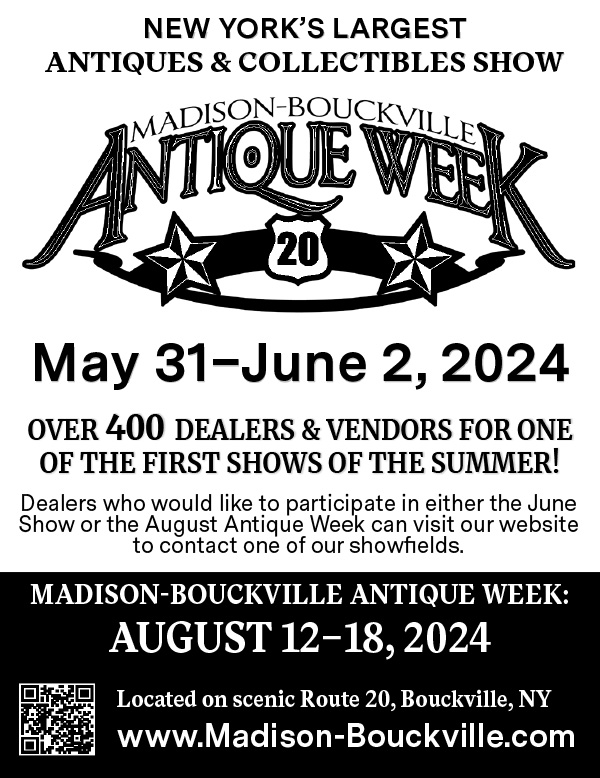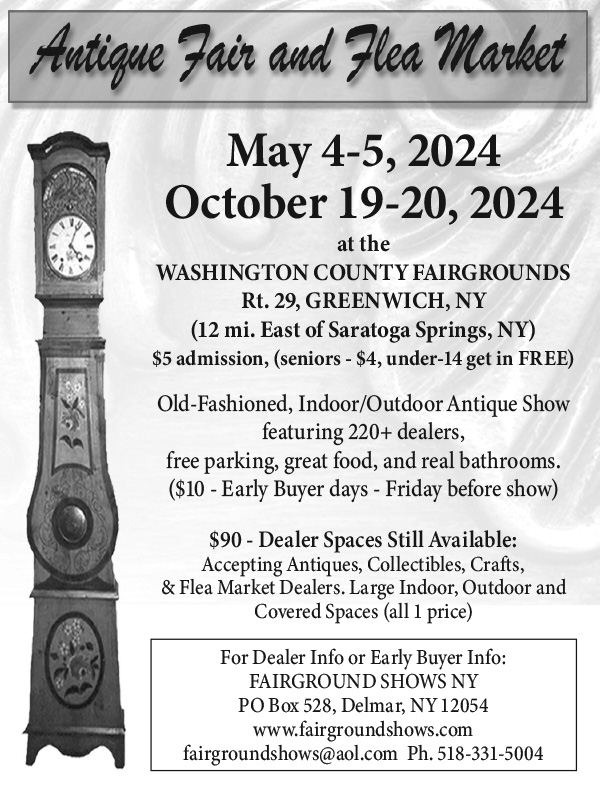It always surprises me when I point out something that’s out of place in a piece of furniture belonging to another person that he has never noticed. I was looking at a one-piece cupboard when I saw something wrong. The piece had two paneled doors below and two in the upper section above an open shelved area. The upper sides had been cut in a scallop form and set back from the bottom.
In the front edge of the shelf that formed the top of the lower section there were two patches about 5 inches in from each side. The patches were the size of desk lid hinges, about 1 ¼” wide, 1 ½” long, and ¼” deep. This told me the piece had been a desk at some point in its life. I felt the drop-front desk lid had been removed and the top cut back to form a type of step-back cupboard. Although he had owned this piece for several years, he never had seen those patches. Later, he told me that every time he looks at the cupboard now, the patches jump out. Too bad he didn’t see them before he bought it. As always, the story is in the details. Sometimes they’re subtle, while at other times they jump out.
An antiques dealer hired me to examine a two-drawer stand she just had purchased. Since she usually doesn’t sell furniture, she wasn’t sure how old it was. She had bought it from another dealer at an outdoor show and had been told she could return it if she found it wasn’t an antique. The seller was sure it was old. But, he mostly sells tools and a few pieces of stoneware. So, he wasn’t too sure how old it was either. I love jobs like this! I get to examine something and tell what I see without having to worry about hurt feelings.
First, there were no signs of shrinkage, no dust, no dirt, no patina or any other indications of age. However, there were signs of modern tool marks in several places. The top had been nailed on from the upper surface. Although “cut” nails had been used, their heads went in several different directions. First, the top should not have been fastened to the base this way. But, second, if a cabinetmaker from the period of these nails had used them, all of the heads would have been going in the same direction, with the longer part of the head following the direction of the wood grain. This is because the nails’ “pointed” ends are rectangular. The wider part of the head should go across the grain to prevent splitting the wood.
The drawer bottoms were old pieces of wood, probably bottoms, that had been cut down to fit these drawers. The undersides had been chamfered to slide the bottom into the dados cut into the sides. One chamfer had been formed with a hand plane, the other with a modern power tool, probably a jointer. The hand-planed side was original, while the other had been chamfered after the bottom had been cut to fit its new location. The bottom in an antique drawer nearly always shrinks and leaves a slight gap in the front. However, these bottoms were in the front dados tightly and the nails holding them in place in the rear had not been moved. The bottoms had no shrinkage. As for the nails in the back, the heads were going the wrong way. I could see split wood.
The drawers had been dovetailed together in the front and nailed in the back. This is unusual, but sometimes found. The dovetails were hand cut, but not very uniform. It appeared they had been cut by someone who wasn’t used to doing that job.
The aprons and drawer dividers weren’t mortise-and-tenoned into place as they should have been. Instead, everything was held in place with ¼-inch dowels going through the legs and into the aprons and so on where they were butted to the legs. On the inside there were small angle irons with two screws each, helping to hold all the joints together. The main wood was maple with a clear finish. There were no signs of age such as dents or nicks. This was a poorly made piece of fake furniture that maybe was 20 years old.
When I told the buyer what I had found, she said she felt dumb. I replied that she should remember the things I had showed her and not be so trusting in the future. Then, I said the textiles and ephemera she carries could be faked and I never would know it. None of us can know everything. But, we should keep learning all the time.
Although there were a lot of antique rocking chairs made, I think today there are almost as many side chairs that have been converted to rockers. A young customer brought a rocking chair to be tightened. When I saw it, I said that it had been converted. She had been told by the seller that it always had been a rocker. He showed her the worn areas on the bottoms of the rockers as “proof.” I pointed out that the lower front stretcher was about an inch above the rocker blades. If this chair had been designed and made to be a rocker, that front stretcher wouldn’t have been there at all, or it would have been a lot higher. In addition, the bottom side stretchers were very close to the blades. She said she didn’t care because she liked the chair and had gotten it for $5 at a flea market. Other than having been converted, it was a nice four-slat New England chair. It’s old, while the rockers aren’t! The low stretchers were the “red flags” here.
When you begin to see “unique” pieces at different locations, and all of them seem to look nearly alike, something is wrong. Several years ago, I saw a casement window frame with a box that had been built around it. It was being called “a unique hanging cupboard with a hinged glass door.” After examining it for a few minutes, I saw what it really was and pointed out the faults to its owner. He wasn’t happy because he thought he had found something special.
Since then, I’ve seen a few others, usually in co-ops. I’m beginning to see more of them. I guess fakers have seen them too and are starting to build them to put in auctions or sell on their own. These small “cupboards” are easy to spot. A casement window is about the same size as a basement window in an old house. This is where the cupboard “doors” generally come from. Some have several small panes of glass, while others have only two. They usually are hinged at the top, with the hinges often showing on the outer surface. The “box” or case can be nearly any kind of wood, usually pine. Most of the ones I’ve seen are painted, although others have been in a “natural” finish. Some have a shelf inside, while others don’t. I saw one little cupboard that was vertical.
If you see one of these, look it over very carefully. Most of them are fakes. If there are any that are truly antique and not made up using a casement window, I haven’t seen one yet. Look at the details such as the nails and saw marks, especially in the sides and rear of the case. These are “cute” items. But, I haven’t seen any that are very old. The door usually is old, but the rest is not.
While walking through a co-op, I spotted a nice-looking Chippendale mirror frame. When I got close enough to see it better, I saw that it was a “Chippendale style” mirror, not a period frame. Examining it more closely, I realized it was made of plywood with mahogany veneer over the wood. The owner was working in her booth. After greeting each other, I told her what I had seen. She was surprised, and changed the tag to add the word “style.”
She had an old frame in her booth. So, I could show her the “red flag” I had seen with the mirror frame – there was no shrinkage. The old frame holding art had shrinkage at the inside corners where the wood met. The mirror frame didn’t have this shrinkage, partly because the wood was plywood and also because it wasn’t old enough to have shrunk. She then looked at other frames she had to be sure they were old. She just had learned something that she was not going to forget.
A friend saw a drop leaf table at an auction house and wanted me to go to the preview with him to check it out. It was cherry with Sheraton turned legs. It looked good, with nice proportions and color. The leaves weren’t very deep. He said it was just the right size for where he wanted to use it. The top was two boards and had been refinished. The surface was very shiny. He felt he could rub it with steel wool to lessen the shine. I said I wasn’t sure because it looked like a polyurethane finish, which can be difficult to dull.
When we looked at the underside of the top, we could see a reason to rethink the purchase. There was a hinge cutout in one of the boards where it joined the other. Also, the one with the cutout had been surfaced with a different tool. The top was a made-up replacement. The aprons and legs seemed to be older than the top. In addition, they did not have that shiny finish. Instead, the finish on the base seemed to be either original or an old shellac one. With that information, he felt he would wait until a better table came along. They’re out there. He needs to wait a bit, be patient.
Next month, we’ll look at more fakes I’ve known.




